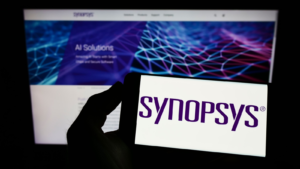There are also many ways to measure momentum. Stock market momentum is much like the momentum we learned about in sciences classes. Everything depends on the principle that objects, or stocks in this case, tend to continue in the same direction once momentum has started.
Bearing that in mind, let’s look at seven stocks that are trending at the moment and why investors should decide to ride that momentum higher.
Nvidia (NVDA)

Nvidia (NASDAQ:NVDA) continues to impress investors from Wall Street to Main Street. Share price broke out again following the release of first quarter earnings on May 22.
The $26 billion in revenues Nvidia reported represented massive growth on a year-over-year basis. And the AI data center opportunity continues to be massive and very apparent, accounting for $22.6 billion of those $26 billion in overall revenues.
The question becomes how much higher can Nvidia run given the fact that it has quickly jumped from under $1,000 to above $1,200. Now it appears that $1,400 is very much a possibility. What objective means can we use to substantiate such an assertion?
I think the answer is gross margin percentage. Generally speaking, gross margin percentage is an indication of emerging durable competitive advantage. That metric rose from 65% to 78% in the last 12 months. It indicates that Nvidia’s pricing power is strengthening, which in turn indicates improving economics within the company.
It’s all another way of stating the fact that Nvidia produces the most in demand chips for AI applications and holds a massive pricing advantage because of that fact. Time will tell how durable that competitive advantage is, but for now it should be enough to keep momentum in Nvidia’s favor.
Palantir (PLTR)

Palantir (NYSE:PLTR) continues to grow and do better than many had expected. In the process, it has become one of the more notable enterprise AI stocks to consider.
Most investors know the story of Palantir by now. It started out as the anti-Silicon Valley analytics firm with a heavy predisposition toward government and defense sector revenue generation. A lot of vested interests wanted the company to fail. It didn’t.
Instead, Palantir reached profitability much quicker than anticipated. Today, it’s a company that boasts six consecutive quarters of GAAP profitability. What’s particularly interesting is that while government side revenues continue to account for the majority of sales, Palantir’s commercial side revenues are growing much faster, at 27% vs. 16%.
That strong commercial growth is both an indication of, and testament to, Palantir’s enterprise AI capabilities. Other enterprise AI competitors including C3.ai (NYSE:AI) have not lived up to their billing. Meanwhile, Palantir continues to quietly establish itself as an emerging force in the AI space. Enterprise AI will continue to account for the majority of AI spending and that simple fact is a strong reason to assume that PLTR stock will continue to rise.
Synopsys (SNPS)

Synopsys (NASDAQ:SNPS) is a critical player within the semiconductor industry that arguably doesn’t get as much attention as it should. While this article isn’t about underappreciated stocks, it is another factor to consider about Synopsys as it trends positively.
The company provides the software used to design some of the most complex AI chips in high demand today. Synopsys’ customer base includes Nvidia, Microsoft (NASDAQ:MSFT), Amazon (NASDAQ:AMZN), Intel (NASDAQ:INTC), Advanced Micro Devices (NASDAQ:AMD) and Broadcom (NASDAQ:AVGO) among others. The company is a critical link in the AI chip supply chain overall.
Investors who look at the stock chart of Synopsys in 2024 will see two distinct trend lines. The second of which began In mid-April. Synopsys could continue to rise higher after raising guidance two weeks ago following a better than expected earnings report. The company expects further growth from the AI chip design software sector which is why the company currently has momentum on its side.
Costco Wholesale (COST)

Costco Wholesale (NASDAQ:COST) has significant momentum on its side. The stock has risen by more than 28% in 2024, and 11% in the last month alone.
Do a bit of research into Costco Wholesale and it becomes evident that shares are overpriced. The company’s current P/E ratio of 52.21 is near all-time highs and well above the 10-year average.
Momentum raises prices so the high P/E ratio shouldn’t be particularly surprising. However, it should raise the question of why investors should continue to believe in Costco at these prices.
The answer has to do with its position as one of the best retail defensive stocks available. It represents a strong play for those who believe that the AI narrative is overblown and have pivoted out as a result. It’s also an excellent choice for those investors who continue to worry whether rate cuts will happen in 2024 at all. So, despite share prices, Costco continues to be a strong choice because of economic uncertainty, not to mention strong growth in the business itself.
MercadoLibre (MELI)

Let’s begin our discussion of MercadoLibre (NASDAQ:MELI) the stock’s with P/E ratio.
MercadoLibre’s P/E ratio is higher than 89% of industry competitors, very similar to Costco. At those levels the question becomes whether or not such evaluation is warranted. I think the answer is yes in the case of MercadoLibre.
Let me present two ideas that I would use to substantiate that assertion. The first is simply that MercadoLibre is the leading fintech company serving the Latin American market. There are substantial opportunities to continue to serve the region’s unbanked population. The astounding growth of MercadoLibre’s payment volume is a strong indication that the company is addressing that opportunity.
The second piece of evidence I would use to suggest MercadoLibre’s current valuation is accurate is gross margin. It has consistently stayed above 40% over the last decade. That level of sustained gross margin indicates MercadoLibre has a sustainable competitive advantage. Simply put, MercadoLibre is a dominant force that will continue to thrive.
McKesson Corporation (MCK)

McKesson Corporation (NYSE:MCK) stock has trended sharply upward over the past few weeks despite the fact that the company disappointed when it released earnings on May 8. The earnings miss was attributed to a slump in demand for branded specialty and generic drugs the distributor sells.
The media hasn’t reported much on the spike in demand for McKesson stock over the last few weeks but I can posit a few theories. Actually, one big theory which I think accounts for the stock’s strong momentum despite weak earnings.
McKesson is one of the three largest drug wholesale distributors in the U.S. that collectively distributes more than 90% of all U.S. prescriptions.
I think the strong performance has to do with the emergence of GLP-1 inhibitors, or weight loss drugs. The company has a golden opportunity to capitalize on the rapid emergence of FDA approved weight loss drugs.
A lot of steam has run out of drug maker stocks like Eli Lilly (NYSE:LLY) and Novo Nordisk (NYSE:NVO) which is why distributors are one of the next logical places to look for GLP-1 opportunities.
Microstrategy (MSTR)

Microstrategy (NASDAQ:MSTR) is an enterprise analytics stock but a company that everyone knows primarily because of its position in Bitcoin (BTC-USD).
Momentum is currently on Microstrategy’s side as Bitcoin prices rise above $70,000 again. The company held 214,000 Bitcoin as of April 26. The company bought those Bitcoins for a total purchase price of $7.54 billion, or an average of $35,180. Yet, the company missed on earnings due to an accounting technicality which is well explained in this video.
Microstrategy stock continues to be an interesting investment solely because of its Bitcoin strategy. The company markets itself as an enterprise AI software firm but it isn’t doing well in that regard. Revenues fell by 5% which indicates that it isn’t a particularly competitive analytics software firm. Anyway, the point here is Microstrategy rises and falls with Bitcoin’s price. Bitcoin is strong again and that shifts momentum in Microstrategy’s favor.
On the date of publication, Alex Sirois did not have (either directly or indirectly) any positions in the securities mentioned in this article. The opinions expressed in this article are those of the writer, subject to the InvestorPlace.com Publishing Guidelines.
Alex Sirois is a freelance contributor to InvestorPlace whose personal stock investing style is focused on long-term, buy-and-hold, wealth-building stock picks. Having worked in several industries from e-commerce to translation to education and utilizing his MBA from George Washington University, he brings a diverse set of skills through which he filters his writing.
